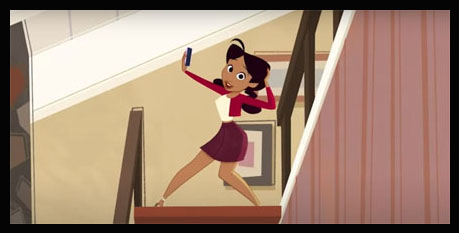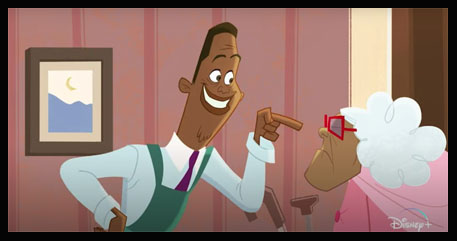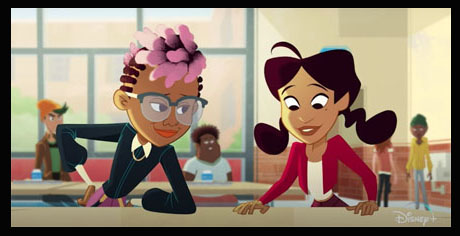
Bruce W. Smith created Disney’s iconic animated series The Proud Family, which premiered in 2001. Ralph Farquhar served as executive producer. Now 21 and a half years later, they’re the creators of Disney+ reboot show The Proud Family: Louder and Prouder. It debuts this Wednesday February 23rd. Smith and Farquhar are proud to give these characters new stories to please millions of families. (This Animation Scoop Q&A was edited for length and clarity.)
Jackson Murphy: Bruce, the last time we spoke was just before Hair Love [which Smith co-directed] won the Academy Award for Best Animated Short Film…
Bruce W. Smith: Yeah, I thought I remembered you.
JM: Yes. And you won the Winsor McCay Annie Award last year. That was such a cool acceptance speech. I could tell you were so honored by that.

BWS: That was fun, man. It was fun to do. It’s an honor to be recognized by your peers for the stuff that you’ve done. For me, I felt that award was so early. I’m still getting started here. You know what I mean? (laughs) The engine is still revving. I appreciated that award. And with The Proud Family: Louder and Prouder, it’s proof that my tank is still running on full, so let’s do this!
JM: Yes! Let’s keep it rolling! Ralph, what has amazed you about the animation technology improvements that have happened since The Proud Family original series went off the air in 2005?
Ralph Farquhar: Look, so much has changed from back in those days. I think we were using pencil and paper. (laughs)
BWS: And not a lot of paper, either, Ralph. We couldn’t make a whole lot of mistakes.
RF: Right! They had erasers on their pencils. We couldn’t afford any more paper. But look — the technology now allows Bruce and his crew to turn things around so much quicker. And for the writing side, it’s so helpful to be able to see the characters. The animatics now are so good. One of our writers who’s new to the process saw the animatics and said, “Oh, we’re done.” I said, “No! No! You gotta send this overseas to have it animated!” That’s been the biggest change and allows us to come together and agree over how to play the beats. If the script needs to be changed or the animation needs to be changed, we can do that now because the technology allows you to.

Creator Bruce Smith, Co-Creator Ralph Farquhar – and Jackson Murphy (center, below)
JM: The show looks great. Penny is now 14 years old. Bruce, tell me about balancing the show for those who grew-up with the first Proud Family, but at the same time a new generation of kids obsessed with Disney+ who are going to want to check this out.
BWS: Updating the show was key for us. We aged up Penny from being a tween to now she’s officially a teen. She’s at the top of her ninth grade class in middle school. We all remember that, right? We thought we were the bomb at the time. “Good, I got all these kids up under me.” And that’s how her crew operates. But at the same time the challenges that are being met as kids in this world are no different than what the kids are meeting today. Social media’s a huge thing, and navigating that space continues to be a challenge to a lot of teens. In our world, instead of Instagram we have Hollagram. That’s a cool component. And having lots of followers on Hollagram means a whole lot to Penny and her crew.
That challenge alone sets the tone of what you’re gonna see this season. For the first time they navigate race among their crew. They talk about really important things that affect our community, like reparations that affect them / the idea of what that is. They also discover the secrets of their town and how it impacts the entire community — and what Penny and her crew do to stand-up to social issues that really matter to their city. We’re putting a lot in the laps of Penny and her crew. It’s inspiring. It’s empowering. And it’s what we do best as The Proud Family.
JM: Yeah. You do a great job of taking us into the modern age of what it’s like to be an influencer / what it’s like to have fame thrown in your face in today’s world. Ralph, was there a moment when you were making this that really took you back to making the original series, going, “Wait a second, it feels like 2002 all over again?”
RF: The first time we started recording Kyla [Pratt] and Tommy [Davidson] and Jo Marie [Payton], it was like, “Well, nothing’s changed.” They’re still the same. It’s just so amazing. And that’s when the anxiety over doing a new show went completely away and we said, “Oh, we got this.” The voices are here. The writing’s here. The animation’s here. This is gonna be hot.

JM: Good. Fans will love hearing the voices again. Bruce, I remember when The Proud Family original show was not only on Disney Channel but on ABC Kids. And that was a big deal when it was on Saturday morning. What was that like to have that be part of the ABC Saturday morning lineup?
BWS: That was pretty cool, actually. Ralph and I talked about this. It was something we didn’t expect. As the show began to perform and gain momentum on the Disney Channel… that synergistic energy made sense to drive eyeballs to ABC by putting it there. This is obviously attracting an audience.
RF: I don’t know about you, Bruce, but I remember thinking, “I’ve been underpaid.” (laughs) But anyway…
BWS: The important thing is that you’ve got a generation of kids who saw it on the Disney Channel and others who didn’t have cable at the time who were seeing it on regular network TV. And it made our audience that much more aware. It was the awareness. You ask people all the time, “Where’d you see it?” “Well, I saw it on ABC.” Or “I saw it on the Disney Channel.” Some saw it on MTV.
RF: Years later we were on BET and also on MTV. The Proud Family has been around.
JM: Yes it has. And now we’re onto Disney+ with the big streaming service. Ralph, because these episodes are basically 30 minutes long — there’s no commercials — could you sense this opportunity to have some flexibility when it came to the stories / more time for each episode?

RF: You bring up a very good point. The advantage of being on a streaming service is you’re not constrained by hard time limits. Although with animation, budget comes into concern. We don’t have extra footage that we can just throw in. We gotta draw that stuff, right? (laughs) But what we have is flexibility. Some of the stories are longer than others. If a story requires more time to tell the story properly, we take it. And that’s really great.
JM: Nice. For both of you: can you pinpoint one thing that you’re most proud of when it comes to this specific new journey you’re on with this revival?
BWS: What’s cool about our show — this version especially — is that we have this “for us, by us” mentality of making this show. So it’s very communal in that sense. So you see me and Ralph, but the important component of the show is Ralph’s writing room. It’s the most diverse and inclusive writing room that I’ve ever worked with in my life. We have two African American female directors. Those are unicorns. You won’t see that anywhere in this industry: two sitting side by side, really navigating through a lot of these episodes… right down to the story artists.
Our production team is full of diverse individuals and also fans of the first version of this show that jumped on board when this opportunity was there. This version has always been about opportunity. We found our crew from pretty much every corner of this planet, from Instagram to Twitter to Ralph and I digging under rocks and saying, “Do you draw? Do you wanna draw? Alright, come on over.” That’s what this show is about, so that’s been a really great journey and it’s been probably the [most fun] part of making this show: seeing all the faces and knowing that our show looks just like our crew.
RF: I can echo that. The thing I’m most proud of is that we have a very diverse crew, top to bottom, something we weren’t able to do the first time around. And we made it a point this time around to also bring in the female point of view in terms of directors and the writing room. We’re very proud of the crew we’ve been able to assemble to make this show, and you’re seeing the fruits of that in the episodes.
- INTERVIEW: Strap In For “Mars Express” - April 30, 2024
- INTERVIEW: Jeff Fowler On “Knuckles” And “Sonic 3” - April 22, 2024
- INTERVIEW: “Inside Out 2” Director And Producer On Pixar Sequel - April 16, 2024


 February 17th, 2022
February 17th, 2022  Jackson Murphy
Jackson Murphy  Posted in
Posted in  Tags:
Tags: 






